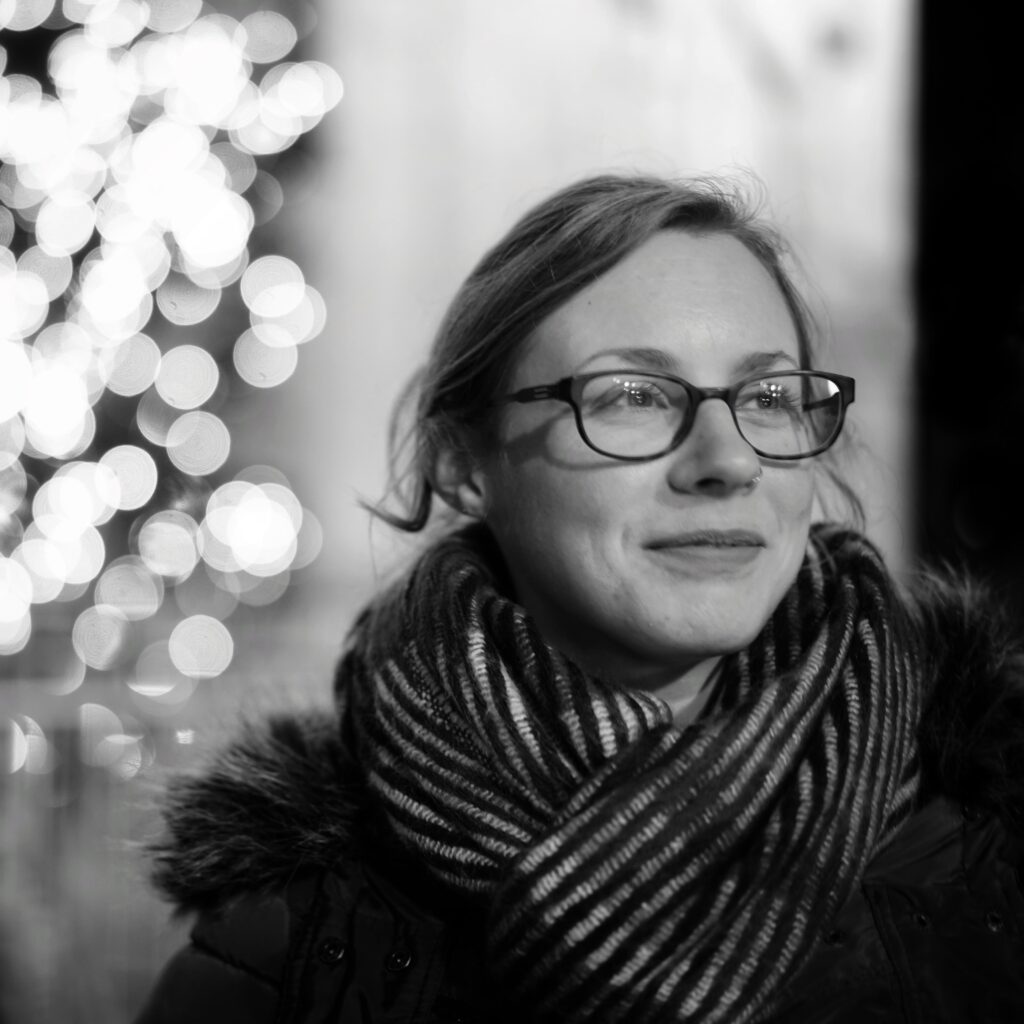
By Erin Calabria
I can’t talk about music without talking about silence.
During high school, when I began composing on the piano, I didn’t tell my teacher. This music wasn’t like anything I’d ever been assigned, the fingerings were meant to fit rather than strain my small hands, and everything was by ear. This music was wrong. It was secret.
Back then, I gathered secrets like charms on a bracelet. Not that I was the only teenager who did this, of course; adolescence is often a period of distrust, of surveillance and survival just before the precarious release into adulthood. My teenaged self believed that the things she didn’t talk about would make a magic circle around her. They could protect her, as long as she protected them.
A first instrument is like a first language. The unique timbre of that instrument, its particular strengths and limitations of expression—all of these imprint and shape your experience of music as a whole, the way a mother tongue creates your conception of language. And while this first instrument’s techniques and idiosyncrasies might not translate directly to a different instrument picked up later, you will be able to hear the divergence, the underlying echo of what isn’t there. To return to a first instrument is like returning to the language of your childhood. It feels like coming home.
For over a decade, I’d been carrying a score with no instrument: a relic or a promise, I hadn’t been sure until we cleared out a corner of the bedroom, and I propped the pages up on a newly-assembled electric piano. Always a stumbling sight-reader, I worked away at the score bit by bit, until I reached a chord that sounded like something shattering. It was a sound I remembered, because I had written it. It was the sound of a girl who couldn’t speak.
For a long time, the only stories I had been able to tell openly were nonverbal ones. They were old stories, made to be told and retold, varied anew like any fairytale with each retelling. I had grown up with Irish tunes in the tape deck on road trips, had tried my hand at a souvenir whistle my parents had left forgotten in a drawer, but it wasn’t until a high school friend played me a set of polkas on her fiddle that tunes became stories to trade back and forth the way our classmates traded nail polish and sweaters.
Irish tunes are known for their evocative names like “Apples in Winter” or “Comb Your Hair and Curl It” or “The Chicken’s Gone to Scotland.” Beyond those names however, there is something about the structure of the tunes and the way they are played that has always made them story-like to me. Firstly, the tunes are concerned less with vertical harmony and more with horizontal melody, which tends to be both rhythmic and lyrical, like a spoken line. Secondly, tunes are usually played one after another in sets of two or more; just the way a story’s architecture depends on both the micro-level of the sentence and the macro-level of the arc, a set of Irish tunes encompasses the micro-narrative of each individual tune’s melody as well as the macro-narrative of the set as a whole.
Of course, those structural principles could be applied to other musical forms, from cello suites to concept albums, but perhaps what makes Irish tunes most story-like is their oral tradition—how they are learned best by listening, how they are most alive when shared in a circle of musicians who pay careful attention to the player who starts a set before joining in, following and expanding the same tune together, each instrument, each individual absorbed into the telling itself.
In Irish literary studies, there is a theory that the near eradication of the Irish language resulted in what critic Seamus Deane called “an almost vengeful virtuosity in the English language”: a maximalist overflowing to reclaim the colonizer’s tongue (and in cases like James Joyce, to protest against the oppressive conformity of Irish nationalism as well)—a simultaneous obliteration and accentuation of a profound linguistic void. I’ve always been struck by that word “virtuosity,” a word so often used in music. As a young person struggling with speechlessness, I don’t think it was a coincidence to be drawn to an oral tradition that insisted: out of silence, comes song.
Of course, I couldn’t have explained this at the time. But I kept gathering tunes, I began fiddle lessons, taking the train out of the city, playing through past repertoire with my teacher and then recording a new tune to work on for the next time. I was developing a practice that wasn’t yet a writing practice, but it was one that valued instead of dismissed my ear, one that emphasized learning instead of perfection, and one that allowed me to tell nonverbal stories without feeling the need to keep them secret. Over time, with enough of those tunes sounding where once only silence had been permitted to dwell, words began to arrive, shaping into stories themselves.
These days, I seek out as much, if not more, storytelling advice from musicians as from writers. Sometimes, I discover inspiration on process, like Tori Amos saying, “The piano is a multi-dimensional thing. You have to allow it to play you and you have to become malleable,”or Laura Jean saying, “Instead of talking about the feeling of having a memory, just create a memory in the song that evokes the feeling of nostalgia.” Other times, I find insight on the artistic life, like Aldous Harding’s observation that “Your place of comfort is not necessarily your place of fulfillment.”
Often, I think about this last idea when I write, and especially when I avoid writing. I think about the way home can be both warm hearth and confining walls, the way a native language—or even silence—can be both safety net and tethering snare.
And if I’m honest, I don’t think I’ve totally outgrown the instinct to keep secrets. After all, a writer has to constantly decide how much to tell, and which lacunae and uncertainties and line breaks to allow so that whatever appears on the page stands out in vivid relief. I’ve also come to agree with Rebecca Lindberg’s assertion that writing doesn’t occur simply “because you ‘have something to say’” but rather “because you have something echoing around in the bone-dome of your skull that you cannot say,” and the negative space of what remains unspoken reveals itself “in the same way that dark matter becomes visible to the astrophysicist. You can’t see it, but by measure of its effect on the visible, it can become so precise a silhouette you can almost know it.” But even beyond what is said or unsaid, we also have to decide what is ours to tell, and what is simply ours.
Now and then, I return to a 1974 interview with Maria Callas, the opera legend once said to have “a big ugly voice” while also being widely adored as “La Divina.” Asked whether she is a lonely person, Callas responds: “We have to be alone. […] It’s our work. I don’t fear loneliness because I’m never alone. I have friends, I have my own interior world. I can live with myself for weeks. I don’t need other people, but I know that other people are willing to be with me when I want. So I’m not really alone.”
Every time, it is a revelation to hear that colossal voice speak about the interior world of the artist, not as a place of hiding or exile but as a place to cultivate and explore, as well as a place the artist can leave behind when they choose. It is that exchange between sound and silence, and the choice to travel between them, that lets me now move between verbal and nonverbal stories, to tell some through music, and some through words, and to keep some to myself, untold.
Outside now, there are sirens and horns. There are bursts of laughter and car stereos and helicopters chopping by. And underneath it all, there is the steady, soughing hum of the city, like a vast lung breathing between pavement and brick and a sky where pigeons wheel on synchronized wings. My ears are doubly-insulated—small, inner buds nestled into large foam headphones so that I can listen and play along to the song I’m learning with just a gentle thump of pedal and keys. Much of the time, this is how I play these days, the electric piano inaudible to anyone except me. But sometimes, I unclamp my ears and unplug all the cords. Sometimes, when I choose, I fill the room with sound.
Sources/Further Reading:
Amos, Tori. “I really can’t do anything besides music.” The Guardian, 11. Oct. 2008, https://www.theguardian.com/lifeandstyle/2008/oct/12/tori-amos-piano-playing
Deane, Seamus. “Introduction.” Nationalism, Colonialism, and Literature. Minneapolis: University of Minnesota Press, 1990, pp 3-22.
Englert, Laura Jean. “Andrew McMillen’s Playlist: Playing with my Memory.” The Australian, 1.1.2019.
Kessler, Ted, host. “Aldous Harding.” Q presents the making of…, 22. Apr. 2019, https://www.planetradio.co.uk/podcasts/q-making-of/id-16116/
McSweeney’s Books. “A McSweeney’s Books Q&A With Rebecca Lindenberg, Author of Love, An Index.” McSweeney’s Internet Tendency, 23. Apr. 2013, https://www.mcsweeneys.net/articles/a-mcsweeneys-books-qa-with-rebecca-lindenberg-author-of-love-an-index
“Maria Callas- Mike Wallace Interview- Part 1.” YouTube, uploaded by StuartLou, 28. Feb. 2010, https://www.youtube.com/watch?v=KnrDb5c7BAg
Read Erin’s other work here at Reckon.

Erin Calabria
Erin Calabria grew up on the edge of a field in rural Western Massachusetts and has since lived in Magdeburg, Germany and New York City. She studied audio storytelling at the Salt Institute for Documentary Studies and is a co-founding editor at Empty House Press, which publishes writing about home, place, and memory. In her spare time, she likes to learn tunes by ear on the piano, fiddle, and tin whistle, or else visit the birds in her neighborhood park. You can read more of her work in Little Fiction, Milk Candy Review, Longleaf Review, Pithead Chapel, and other places.
